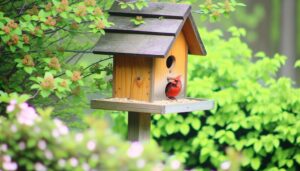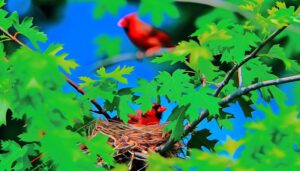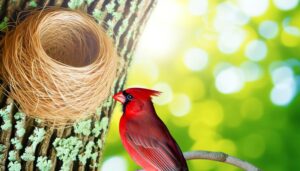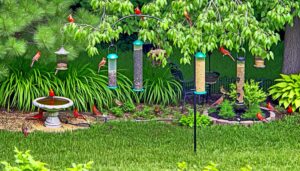Place Birdseed Far Away: 3 Tips for Cardinal Nest Safety
Place birdseed 20-30 feet away from cardinal nests. This distance respects their territorial nature and reduces stress.
Cardinals fiercely guard their nesting areas, so avoiding nearby disturbances is essential. By placing seed further away, you encourage natural foraging behaviors, which supports their health.
Choose a feeder type that suits cardinals, like hopper or platform feeders, and make sure it's located in a predator-free zone, ideally 5-7 feet above the ground. Maintaining this distance helps adult cardinals and fledglings thrive.
Understanding these details leads to a healthier environment for your backyard cardinals.
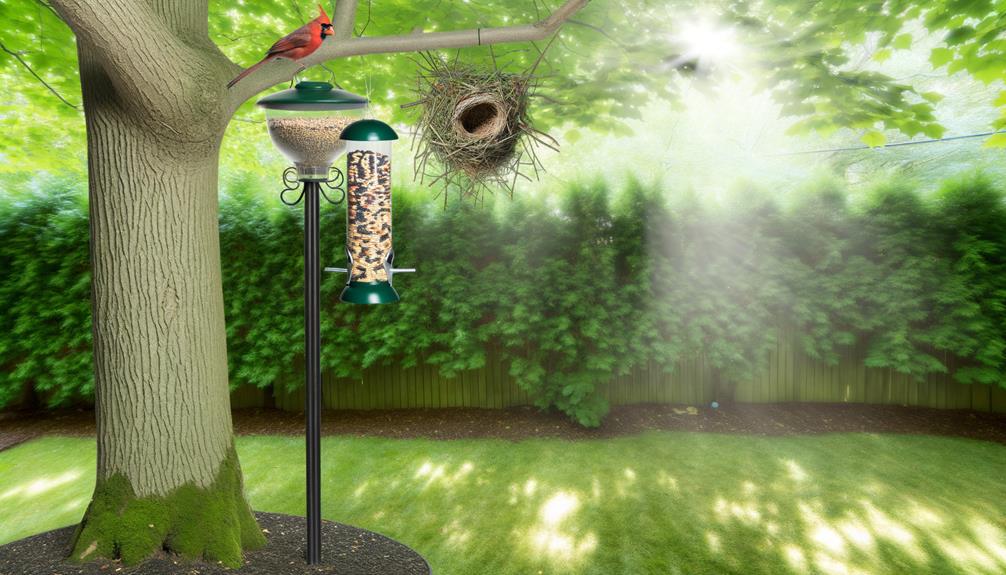
Key Takeaways
- Position birdseed 20-30 feet away from cardinal nests to preserve territorial integrity.
- Placing birdseed at this distance reduces stress on nesting cardinals.
- Encourages cardinals to engage in natural foraging behaviors.
- Helps ensure adult cardinals and fledglings remain undisturbed.
- Promotes a healthier environment for cardinals by maintaining an appropriate distance.
Understanding Cardinal Behavior
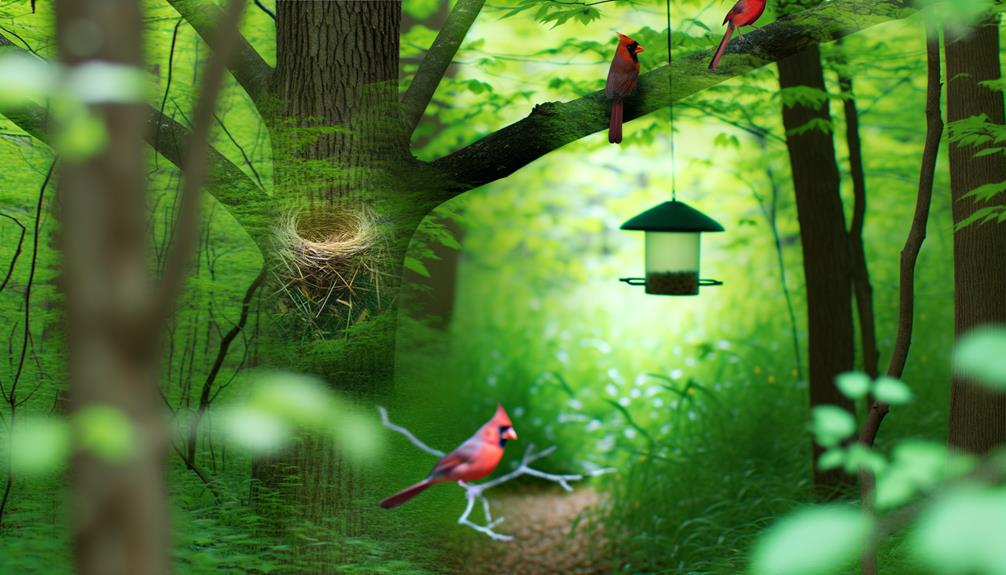
To successfully position birdseed away from a cardinal nest, you must first comprehend their territorial behavior and feeding patterns.
Cardinals are highly territorial, particularly during breeding season. They'll fiercely guard their nesting area, which can extend up to a few hundred square feet. Cardinals prefer dense shrubbery or trees for nesting, and they often search for food within their territory.
They consume seeds, insects, and fruits, usually foraging close to the ground or in low vegetation. By situating birdseed outside their immediate territory, you allow cardinals to maintain their natural foraging behaviors without feeling threatened.
Understanding these patterns helps you ensure the birdseed placement supports the cardinals' need for security and autonomy, fostering a balanced and natural environment.
Ideal Distance From Nest
Positioning birdseed at least 20 to 30 feet away from a cardinal nest helps preserve their territorial integrity and reduces stress. This distance guarantees that cardinals feel secure in their nesting area, minimizing disturbances and potential threats. Additionally, it encourages natural foraging behaviors, promoting a healthier environment for both adult cardinals and their fledglings.
Here's a quick reference guide to ideal distances:
| Distance (Feet) | Benefits | Considerations |
|---|---|---|
| 20 | Security, reduced stress | Moderate foraging |
| 25 | Best balance | Enhanced comfort |
| 30 | Maximum territorial space | Increased safety |
| 35 | Extended buffer zone | Less frequent visits |
| 40 | High protection | Potential range loss |
Maintaining this ideal distance ensures cardinals remain undisturbed while still benefiting from accessible food sources.
Types of Bird Feeders
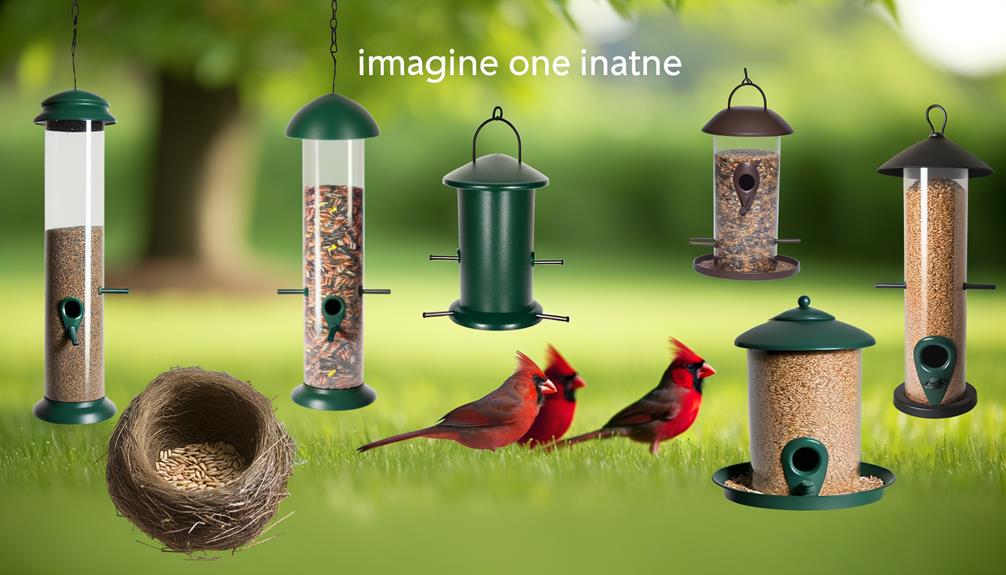
When selecting a bird feeder, you'll find that hopper feeders offer ample storage and weather protection for birdseed.
Tube feeders come in various designs, making them suitable for different seed types and bird species.
Platform feeders provide an open space that accommodates multiple birds and prevents seed waste.
Hopper Feeder Benefits
Hopper feeders are recognized for their versatility and ease of use. They offer an effective way to dispense birdseed while keeping it dry and protected from the elements.
You'll discover that these feeders provide numerous benefits for both you and the birds.
- Weather Protection: The covered design guarantees seeds stay dry, preventing mold growth.
- Seed Dispensing: Gravity-fed mechanisms enable continuous seed supply, minimizing your requirement for frequent refills.
- Durability: Frequently made from sturdy materials like metal or durable plastic, they can endure harsh weather conditions.
Tube Feeder Varieties
Tube feeders, known for their elongated shape and multiple feeding ports, offer a specialized approach to attracting a variety of bird species. You can choose from different designs, such as those with larger ports for mixed seeds or smaller ones specifically for thistle seed, which goldfinches adore. Tube feeders often feature perches aligned with feeding ports, allowing birds to comfortably access food.
Look for models with squirrel-proof mechanisms, as they'll help keep the feed safe from unwanted visitors. When placing tube feeders, aim for a location that's visible but not too close to the cardinal nest. This spacing helps reduce stress on nesting birds while still offering them a reliable food source and encouraging diverse avian visitors to your yard.
Platform Feeder Advantages
Platform feeders, unlike tube feeders, offer an open design that accommodates larger birds and provides easy access to various types of birdseed. This design makes them ideal for attracting cardinals and other medium to large-sized birds.
Here are three key advantages of using platform feeders:
- Versatility: You can offer a diverse mix of seeds, fruits, and nuts, appealing to a wider range of bird species.
- Accessibility: The open platform allows birds to land and feed comfortably, reducing competition and stress among them.
- Visibility: Birds have a clear view of their surroundings, making them feel safer and more likely to visit your feeder.
Choosing the Right Birdseed
Selecting the appropriate birdseed is vital for attracting and nourishing cardinals while ensuring the safety and health of their nest. Cardinals prefer seeds like sunflower, safflower, and millet.
Sunflower seeds, both black-oil and striped, provide high-fat content, essential for energy. Safflower seeds, less appealing to other birds and squirrels, offer an effective dietary choice. Millet, especially white proso, is another cardinal favorite but should be used sparingly due to its allure for other species.
Ensure the birdseed is fresh and free of mold to avoid health risks. Opt for a blend specifically formulated for cardinals, which typically includes these preferred seeds. Avoid fillers like wheat and milo, as cardinals generally ignore them, and they can attract less desirable birds.
Avoiding Predators
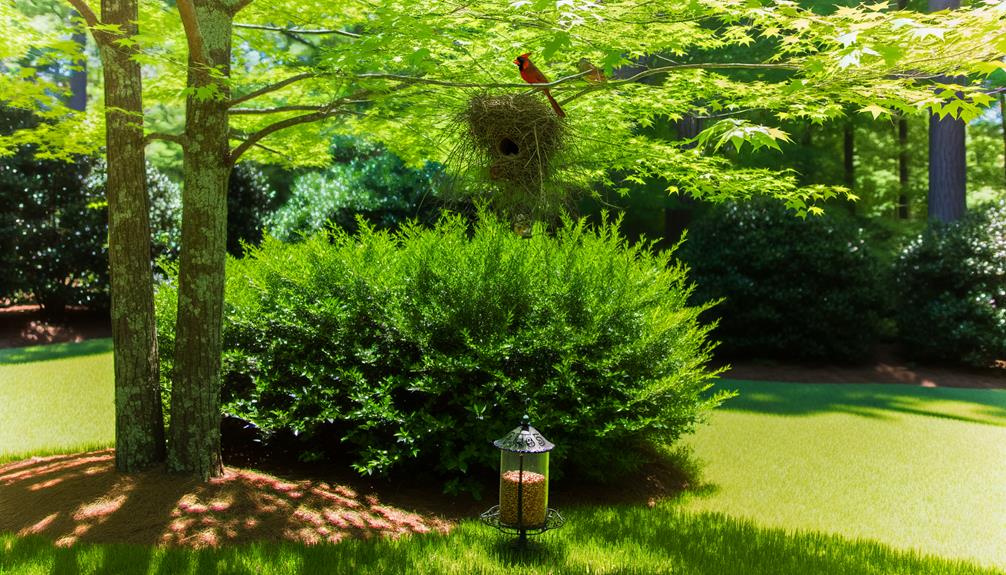
While selecting the appropriate birdseed is crucial, positioning it strategically can help you avoid attracting predators to the cardinal nest. To minimize risk, consider the following:
- Distance: Position the bird feeder at least 30 feet away from the nest. This decreases the likelihood of predators locating the nest while foraging.
- Height: Place the feeder 5-7 feet above the ground. This elevation deters ground predators such as cats and raccoons.
- Visibility: Ensure the feeder is in a spacious area with a clear line of sight. Avoid dense vegetation where predators might conceal themselves.
Creating a Safe Environment
To create a safe environment, you should establish predator-free feeding zones by placing birdseed in areas less accessible to threats. Confirm these zones are near natural shelters like shrubs or trees, providing quick refuge for cardinals.
Always maintain a safe distance from the nest to avoid attracting predators to the nesting site.
Predator-Free Feeding Zones
Establishing predator-free feeding zones involves strategically placing bird feeders in locations that minimize the risk of predation, ensuring a safe environment for cardinals and other small birds.
To create such zones, follow these guidelines:
- Elevate Feeders: Position feeders at least 5-6 feet off the ground to deter ground predators like cats and raccoons.
- Distance from Cover: Place feeders at least 10 feet away from dense shrubs or trees where predators can hide and ambush.
- Use Baffles: Install baffles on feeder poles to prevent squirrels and other climbing predators from reaching the birdseed.
Natural Shelter Proximity
Positioning bird feeders close to natural shelters such as trees or shrubs can provide cardinals with quick escape routes from potential threats. Place feeders within 10-15 feet of dense foliage, offering cardinals a safe haven while they feed. This closeness enables them to detect and avoid predators effectively.
Indigenous plants are preferable as they provide familiar cover and extra food sources. Refrain from situating feeders in exposed, open areas as these heighten vulnerability. By establishing a harmonious environment with easily accessible shelter, you're granting cardinals a sanctuary that enhances their sense of liberty.
Regularly monitoring the area for potential dangers guarantees the security of these colorful birds. Keep in mind, a well-thought-out arrangement fosters a robust and flourishing cardinal population.
Safe Distance Maintenance
When placing birdseed, maintain at least a 20-foot distance from the cardinal nest to minimize disturbances and reduce the risk of attracting predators. This distance ensures that cardinals feel secure and that the nest remains undisturbed.
Here are some critical points to keep in mind:
- Predator Prevention: A 20-foot gap reduces the chance of predators like cats or larger birds being drawn to the nest.
- Stress Reduction: Minimizing human interaction near the nest decreases stress for the cardinals, promoting healthier breeding conditions.
- Optimal Foraging: Placing birdseed farther away encourages natural foraging behavior, which is beneficial for the cardinals' well-being.
Seasonal Considerations
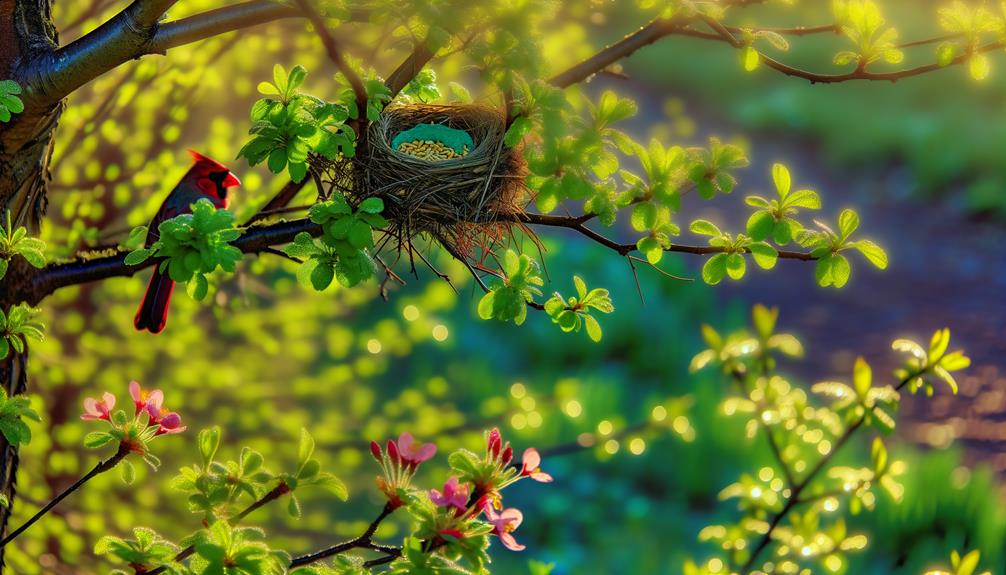
Considering seasonal changes, placing birdseed away from a cardinal nest can help minimize disturbances during critical breeding and nesting periods. During spring and early summer, cardinals are particularly sensitive, requiring a quiet environment for successful mating and rearing of their young.
You should place birdseed feeders at least 20 feet from the nest to reduce human and predator traffic.
In autumn and winter, cardinals' nesting activity decreases, allowing for more flexibility. However, maintaining a similar distance can still prevent unnecessary stress. Always prioritize natural food sources like berries and insects during these times.
Monitoring Cardinal Activity
To effectively monitor cardinal activity, observe their behavior during various times of the day and note any patterns in feeding, nesting, and territorial interactions. Start by documenting their habits to gather detailed data.
- Morning Observations: Cardinals are most active during dawn. Note their feeding and singing behaviors.
- Midday Activity: Track their nesting and resting periods. Observe any changes in territorial behavior.
- Evening Patterns: Monitor their pre-roosting activities. Cardinals often forage for food before settling down.
Maintaining the Feeder
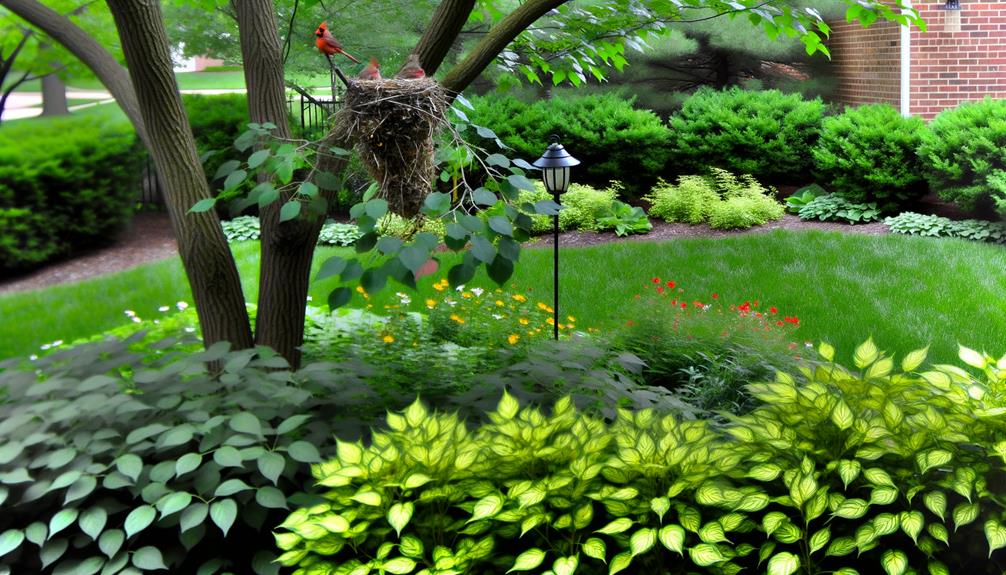
Regularly cleaning the bird feeder makes certain that cardinals have access to fresh, uncontaminated food. You should clean the feeder every two weeks using a solution of one part bleach to nine parts water. Rinse thoroughly and let it dry completely before refilling. This practice prevents mold and bacteria buildup, which can harm cardinals.
Here's a quick guide to maintaining your feeder:
| Action | Frequency | Purpose |
|---|---|---|
| Clean with bleach | Every 2 weeks | Prevent mold and bacterial growth |
| Inspect for damage | Monthly | Guarantee feeder is safe and functional |
| Replace old seed | Weekly | Provide fresh, nutritious food |
| Monitor seed levels | Daily | Ensure constant food availability |
| Adjust placement | Seasonally | Optimize feeding and minimize predation risk |
Conclusion
By carefully placing birdseed at the ideal distance from the cardinal nest, you're ensuring their safety and nourishment. Opt for the right feeders and birdseed, and remain vigilant against predators.
Think of your yard as a fortress; every detail counts. Regularly monitor cardinal activity and adapt to seasonal changes.
With these steps, you'll create a thriving habitat that supports these beautiful birds and allows you to enjoy their presence year-round.

